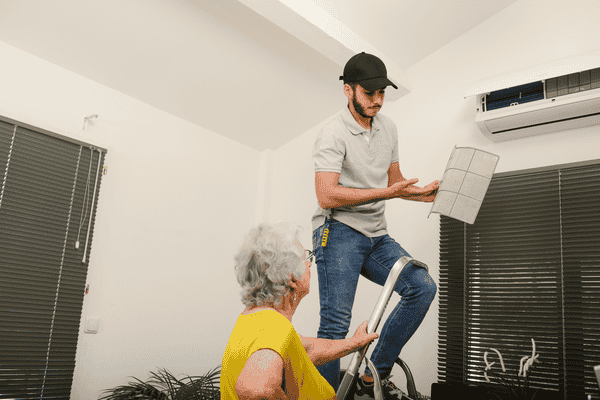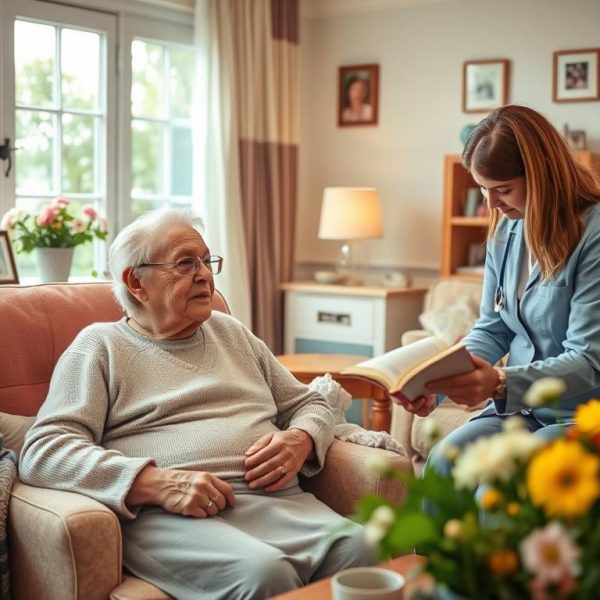On a crisp autumn afternoon, Margaret sat comfortably in her favorite armchair, gazing out the window of her small apartment. The trees outside had begun to turn a rich gold, and a gentle breeze was blowing through the street below. Yet, despite the beauty of the season, Margaret couldn’t shake the persistent discomfort in her chest. Lately, she’d been coughing more, and it seemed like her once-robust immune system wasn’t what it used to be.
Margaret was 82, a proud grandmother of five, and had always prided herself on staying healthy. But as the colder months approached, she found herself more susceptible to colds, and the tightness in her chest was starting to concern her. Her son, David, suggested she get some fresh air every day, but Margaret wasn’t sure that was enough. Something else seemed to be amiss, and it wasn’t until a conversation with her doctor that the real culprit was uncovered: poor indoor ventilation.
The Hidden Dangers of Poor Ventilation
Many seniors like Margaret spend a significant amount of time indoors, especially during the colder months. But while staying inside offers protection from the elements, it can sometimes introduce a new set of problems. Poor ventilation in indoor spaces is a silent contributor to increased respiratory issues and infections, especially for the elderly.
When rooms lack proper airflow, indoor air becomes stagnant, trapping allergens, pollutants, and even viruses. For someone with a compromised immune system, like Margaret, this can be particularly dangerous. The elderly are more vulnerable to infections such as colds, influenza, and pneumonia, all of which can be exacerbated by the presence of indoor pollutants and poor air quality.
The Relationship Between Ventilation and Health
As Margaret’s doctor explained, indoor air quality plays a crucial role in overall health—especially for the elderly. In spaces with inadequate ventilation, air contaminants build up, and oxygen levels can drop, making breathing more difficult. Moreover, viruses and bacteria tend to linger longer in poorly ventilated areas, increasing the risk of infection.
In fact, studies have shown that good ventilation can reduce the transmission of airborne diseases by dispersing pathogens and increasing the overall air exchange in a room. For seniors, whose immune systems are naturally weaker, this can be a lifesaver.
Why the Elderly Are More Vulnerable
Margaret wasn’t the only one in her senior living community experiencing these problems. Many of her friends had also been complaining of persistent colds and respiratory issues. It turns out, there are several reasons why seniors are more vulnerable to infections in poorly ventilated environments.
1. Weakened Immune Systems
As people age, their immune systems naturally become less effective at fighting off infections. This means that seniors are more likely to catch viruses and bacteria that may be circulating in poorly ventilated rooms. For Margaret, even a minor cold could turn into something more serious like bronchitis or pneumonia.
2. Chronic Health Conditions
Many elderly individuals live with chronic health conditions such as asthma, COPD, or heart disease. Poor air quality can aggravate these conditions, leading to worsening symptoms. Margaret had mild asthma, and her doctor explained that the lack of fresh air in her apartment was likely contributing to her increased coughing and chest discomfort.
3. Slower Recovery Time
Even when seniors do recover from infections, it often takes them longer than it would for younger individuals. For someone like Margaret, this meant that even a minor respiratory infection could linger for weeks, reducing her quality of life.
Margaret’s Journey to Cleaner Air
Determined to feel better, Margaret began researching ways to improve the air quality in her home. She realized that while opening a window for a few minutes each day was a good start, it wasn’t enough to truly improve the ventilation in her space. She needed to make some more intentional changes.
1. Opening Windows Regularly
Margaret’s first step was to establish a routine of opening her windows for short periods each day, even when the weather was cool. She learned that allowing outdoor air to flow into her apartment helped dilute indoor pollutants and bring in much-needed fresh air.
Her son, David, also suggested that she place a fan near the window to help push out the stale air and draw in fresh air from outside. Margaret found that doing this for just 15 minutes in the morning and again in the evening made a noticeable difference in how she felt.
2. Using Air Purifiers
While fresh air was helpful, Margaret wanted to go further. Her doctor recommended an air purifier specifically designed for people with respiratory issues. After doing some research, Margaret invested in a high-efficiency particulate air (HEPA) filter, which captured airborne particles like dust, pet dander, and bacteria.
Within a few days of running the purifier in her living room, Margaret noticed her coughing had decreased. Her apartment felt less stuffy, and she could breathe easier at night. The air purifier not only removed pollutants but also helped circulate air, further improving the overall ventilation of her home.
3. Checking and Maintaining HVAC Systems
Margaret realized that her building’s heating, ventilation, and air conditioning (HVAC) system played a significant role in her indoor air quality. After consulting with her building manager, she learned that the system’s filters hadn’t been replaced in quite some time.
David helped her advocate for more frequent filter changes in the building’s common areas and apartments. Once the HVAC system was properly maintained, Margaret felt the difference almost immediately. The air felt fresher, and she had fewer respiratory symptoms, especially in the common areas where she spent time with friends.
4. Avoiding Indoor Pollutants
Beyond improving ventilation, Margaret made a conscious effort to reduce indoor pollutants. She switched to using natural cleaning products and avoided scented candles and air fresheners, which could release harmful chemicals into the air. She also made sure to ventilate her kitchen when cooking, as the fumes from gas stoves could contribute to poor indoor air quality.
The Positive Impact of Proper Ventilation
With these changes, Margaret’s health improved significantly. Her chronic cough faded, and she felt more energetic and resilient. She also shared her newfound knowledge with her friends in the senior living community, many of whom were experiencing similar issues. Together, they worked with the building management to ensure that ventilation systems were properly maintained, benefiting everyone in the community.
Margaret’s story is a powerful reminder of the importance of proper ventilation, especially for seniors who may already be vulnerable to infections and respiratory issues. By making small, simple changes to her environment, Margaret was able to reduce her vulnerability to illness and improve her overall well-being.
Practical Tips for Improving Ventilation and Protecting Seniors
Margaret’s journey offers valuable insights for other seniors or caregivers looking to improve indoor air quality and reduce the risk of infections. Here are some practical tips:
- Open Windows Regularly: Even during colder months, try to open windows for at least 10-15 minutes a day to allow fresh air to circulate and reduce the buildup of indoor pollutants.
- Use Air Purifiers: Invest in a high-quality air purifier, particularly one with a HEPA filter, to help remove harmful particles from the air. This is especially important for seniors with respiratory issues.
- Maintain HVAC Systems: Ensure that heating and ventilation systems are properly maintained, and replace filters regularly to improve air quality.
- Ventilate During Cooking: Use kitchen exhaust fans or open windows when cooking to reduce the buildup of fumes and pollutants.
- Avoid Indoor Pollutants: Reduce the use of products that release harmful chemicals into the air, such as aerosol sprays, air fresheners, and harsh cleaning products.
- Monitor Air Quality: Keep an eye on indoor air quality using an air quality monitor, which can alert you to high levels of pollutants.
Conclusion: A Breath of Fresh Air
For seniors like Margaret, improving ventilation and air quality is a simple but powerful way to safeguard their health. By addressing the issue of poor indoor air quality, seniors can reduce their vulnerability to infections, improve their respiratory health, and enjoy a better quality of life.
Margaret’s story reminds us that even in small urban apartments, we can take control of our environment and create spaces that promote health and well-being. Through simple steps like opening windows, using air purifiers, and maintaining ventilation systems, seniors can take a breath of fresh air—literally—and thrive in their homes for years to come.








